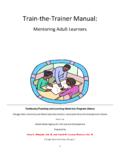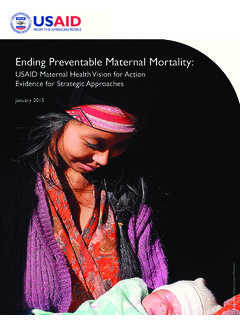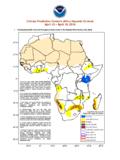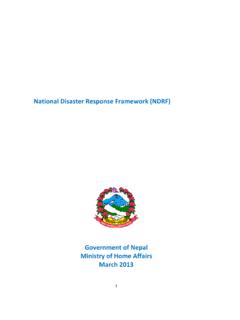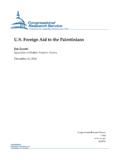Transcription of Pan American Health Organization (PAHO) Hygiene …
1 Water, sanitation and HygieneSanitation and Hygiene Promotion Programming GuidanceSanitation andHygiene PromotionProgramming GuidanceISBN 92 4 159303 2 This document was jointly produced by the following organisations:London School of Hygiene & Tropical Medicine (LSHTM)Keppel Street, London WC1E 7HT, United KingdomTel: +44 20 7636 8636 Fax: +44 20 7436 5389 Website: American Health Organization (PAHO)Pan American Sanitary Bureau,Regional Office of the World Health Organization525 Twenty-third Street, , 20037, United States of AmericaTel: +1 202 974 3000 Fax: +1 202 974 3663 Website: Nations Children Fund (UNICEF)Water, Environment and sanitation Programme Division3 UN Plaza, New York, NY 10017, United States of AmericaTel: +1 212 824 6307.
2 +1 212 326 7371 Fax: +1 212 824 6480 Website: Agency for International Development (USAID)Bureau for Global Health , Infectious Diseases DivisionEnvironmental Health Team, USAID/GH/HIDN/IDRonald Reagan Building,Washington, DC 20523-1000, United States of AmericaTel: +1 202 712 0000 Fax: +1 202 216 3524 Websites: Water, Engineering and Development Centre (WEDC)Loughborough University, Leicestershire LE11 3TU, United KingdomTel: +44 1509 222885 Fax: +44 1509 211079E-mail: Website: and sanitation Program (WSP)1818 H Street, ,Washington, 20433, United States of AmericaTel: +1 202 473 9785 Fax: +1 202 522 3313, 522 3228E-mail: Supply and sanitation Collaborative Council (WSSCC)International Environment House, 9 Chemin des An mones,1219 Ch telaine, Geneva, SwitzerlandTel: +41 22 917 8657 Fax: +41 22 917 8084E-mail: Website: Health Organisation (WHO)Avenue Appia 20, 1211 Geneva 27, SwitzerlandTel: +41 22 791 2111 Fax: +41 22 791 3111 Email: Website: volume is dedicated to the memory of Dr.
3 John of USAID (1929-2004)in recognition of his contributions to the water supply, sanitation and Hygiene sector ina career spanning over six decades working in all corners of the andHygiene PromotionProgramming GuidanceSanitation and Hygiene Promotion Programming GuidanceWHO Library Cataloguing-in-Publication DataSanitation and Hygiene promotion: programming sanitation 2. Hygiene 3. Water supply 4. Health promotion 5. Program development I. Water Supply and sanitation Collaborative 92 4 159303 2 (NLM classification: WA 670) Water Supply and sanitation Collaborative Council and World Health Organization , 2005 All rights publication can be obtained from:Water Supply and sanitation Collaborative Council, International Environment House, 9 Chemin des An mones, 1219 Ch telaine, Geneva, Switzerland (tel: + 41 22 917 8657, fax: + 41 22 917 8084, email: Press, World Health Organization , 20 Avenue Appia, 1211 Geneva 27, Switzerland (tel: +41 22 791 2476; fax: +41 22 791 4857.))
4 Email: Requests for permission to reproduce or translate this publication whether for sale or for noncom-mercial distribution should be addressed to the Water Supply and sanitation Collaborative Council. The designations employed and the presentation of the material in this publication do not imply theexpression of any opinion whatsoever on the part of WSSCC or WHO concerning the legal status ofany country, territory, city or area or of its authorities, or concerning the delimitation of its frontiers orboundaries. Dotted lines on maps represent approximate border lines for which there may not yet befull reasonable precautions have been taken by WSSCC and WHO to verify the information containedin this publication.
5 However, the published material is being distributed without warranty of any kind,either express or implied. The responsibility for the interpretation and use of the material lies with thereader. In no event shall the WSSCC or WHO be liable for damages arising from its by MediaCompany Berlin Printed in GenevaContributionsThe development of this document was led by a team consisting of John Austin (USAID), Lizette Burgers (UNICEF),Sandy Cairncross (LSHTM), Andrew Cotton (WEDC / WELL), Val Curtis (LSHTM), Barbara Evans (consultant), Ger-ardo Galvis (PAHO/CEPIS), Pete Kolsky (WSP), Eddy Perez (EHP), Fred Rosensweig (EHP) and Darren Saywell(WSSCC).
6 It was produced under the overall direction of Gourisankar Ghosh of WSSCC and John Borrazzo of comments and inputs were provided by Len Abrams (World Bank), Adam Biran (LSHTM), Clarissa Brockle-hurst (consultant), Jennifer Davis (MIT), Jennifer Francis (GWA), Eckhard Kleinau (EHP), Eugene Larbi (TREND), ShonaMcKenzie (consultant), Brian Reed (WEDC / WELL), Kevin Samson (WEDC / WELL), Ines Restrepo (CINARA), Car-oline van den Berg (World Bank), Christine van Wijk-Sijbesma (IRC, on behalf of Gender Water Alliance), Minne Ven-ter Hildebrand (Umgeni Water) and Merri Weinger (USAID).
7 A draft was circulated and discussed at the SADC Water, sanitation and Hygiene Meeting (Gaborone August 7 - 11, 2003).The document was prepared by Barbara Evans. Substantial text contributions were made by Fred Rosensweig (Chap-ter 3), Eckhard Kleinau (Chapter 7) and Pete Kolsky (Chapter 10). Design and production was managed by S ren Bauer, 1997 UNICEF Handbook which forms the basis for some sections of this document was prepared by a consult-ant team consisting of Jake Pfohl (principle author), Isabel Blackett and Clifford Wang. Additional inputs and commentswere provided by Steve Esrey, TV Luong, and Gourisankar Ghosh (UNICEF), John Austin and John Borrazzo (USAID),Eddy Perez, Diane Bendahmane, Betsy Reddaway and Darlene Summers (EHP / USAID), Mayling Simpson-Herbert(WHO).
8 Review was provided by Massee Bateman and Fred Rosensweig (EHP / USAID), Sandy Cairncross (LSHTM)and members of the UNICEF sanitation Working and Hygiene Promotion are amongst the most challenging development sectors in which to work. This ispartly because effective sanitation requires the development of public policy in an arena which is intensely private andwhere results are only achieved when the household makes appropriate choices. Because of the complexity of the sec-tor, and in light of the relatively small body of public policy experience, it is inevitable that the current document willrepresent a work in progress.
9 Hopefully with the new interest in the sector, there will be new ideas and experiencesto reflect on in the coming few years. Where readers feel that the current document can be usefully updated, changedor amended in any way to reflect such experience they are encouraged to contact: Water Supply and sanitation Collaborative Council (WSSCC)International Environment House, 9 Chemin des An mones, 1219 Ch telaine, Geneva, SwitzerlandTel: + 41 22 917 8657 Fax: + 41 22 917 8084 Email: Website: and Hygiene Promotion Programming GuidanceIITable of ContentsA Note to the Reader.
10 1 SECTION ONE sanitation AND Hygiene PROMOTION GENERAL PRINCIPLES ..6 Chapter 1 The Basics .. More than 2 billion people lack access to hygienic means of personal sanitation .. Increased access to sanitation and Better Hygienic Practices Have Significant Positive Impacts .. Improved Access to Hardware and Changes in Behaviour at the Household are Critical Interventions .. Lessons for effective sanitation and Hygiene promotion programming: Supporting investments and behaviour changes within the household .. The Role of Government some principles.










